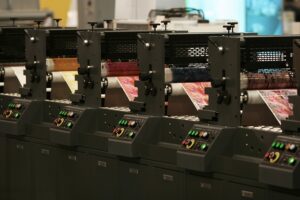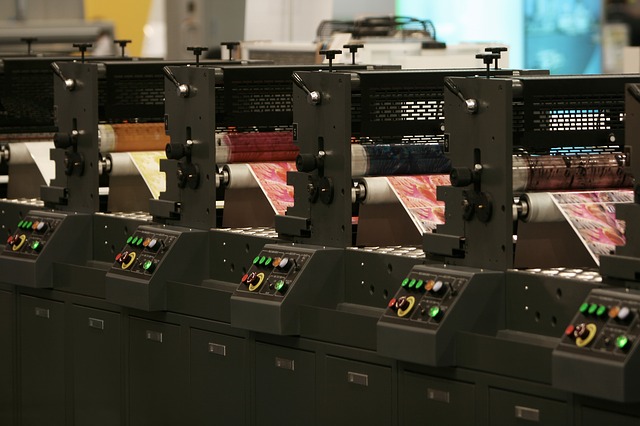
When one mentions printing presses, there is a good chance that an image of Gutenberg comes to mind.
Indeed, this invention was made in 1436 by Johannes Gutenberg who developed a method for metal movable type and adapted existing screw presses to his new system.
However, it remains true that the printing press was not Gutenberg’s original invention.
In fact, there were actually predecessors to the printing press that were created in Asia centuries before Gutenberg’s time.
The earliest printing technology involved carved wooden blocks that were inked and then pressed onto paper. This technology was used in China as early as the 8th century AD.
Then, in Korea, there was a similar technology in use in 1234. This technique consisted of pressing characters into wooden blocks by using a flat surface and an inked pad that was transferred to the wood.
However, it is Gutenberg’s technology that brings us the iconic printing presses we know today: he made three major improvements on existing techniques when designing his printing press.
- Firstly, he used movable type which could be reused.
- Secondly, he came up with a method to print from both sides of the paper simultaneously.
- And thirdly, he developed an oil-based ink that would not smudge.
These three improvements made the printing press a viable and efficient way to produce large quantities of text.
The technology quickly spread throughout Europe and the rest of the world, revolutionizing the way information was disseminated.
When Was the Printing Press Invented?
Bi Sheng was the inventor of Chinese movable type printing. He was a government official during China’s Song Dynasty (960-1279).
Bi Sheng is credited as the inventor of a method that involved carving characters into pieces of clay, which were then baked and assembled into shape.
The Bi Sheng printing press had been introduced in 1040 through the Hui-wen Chih-shu (Preface of copulating types) book.
However, it is recorded that Bi Sheng had been carving the individual characters and assembling them into shape at least 20 years before that time.
The world’s first movable type printing system was invented in East Asia around 1040 AD by a Chinese government official named Bi Sheng.
Johannes Gutenberg’s Printing Press
Johannes Gutenberg, who is more commonly associated with the printing press, invented a metal movable type process in the 15th century.
This allowed for multiple copies of the text to be printed at once, which was a major improvement on the woodblock printing technology that was in use at the time.
Gutenberg’s printing press quickly gained popularity throughout Europe and the rest of the world, revolutionizing the way information was disseminated.
Printing Spreads Through Europe
The printing press was brought to Europe by Johannes Gutenberg in the 15th century.
At first, the technology was met with some resistance due to the fact that it threatened the livelihoods of many scribes and booksellers.
However, the printing press eventually gained wide acceptance and became a staple of European society.
The printing press quickly spread throughout Europe and the rest of the world, revolutionizing the way information was disseminated.
The technology allowed for large quantities of text to be produced at a fraction of the cost of traditional methods. This made it possible for knowledge and ideas to be shared more widely than ever before.
The printing press has had a profound impact on society, the economy, and the way we communicate.
It is one of the most important inventions in history, and we owe its existence to the ingenuity of Johannes Gutenberg.
How Did Printing Presses Evolve?
The printing press has come a long way since Johannes Gutenberg first invented it. In fact, it has changed so much that it is now difficult to imagine a world without it.
Over the years, printers have developed new and innovative ways to produce text.
This has included the introduction of movable type printing, the use of steam power, and the adoption of digital technology.
Each of these developments has helped to make the printing press more efficient and cost-effective. They have also allowed printers to produce text in a variety of different formats, including newspapers, magazines, books, and posters.
The printing press has come a long way since Johannes Gutenberg first invented it.
In fact, it has changed so much that it is now difficult to imagine a world without it.
Over the years, printers have developed new and innovative ways to produce text. This has included the introduction of movable type printing, the use of steam power, and the adoption of digital technology.
Each of these developments has helped to make the printing press more efficient and cost-effective. They have also allowed printers to produce text in a variety of different formats, including newspapers, magazines, books, and posters.
- Related post: The history of how the telegraph was invented
- Related post: How was paper invented for the first time and discovered
What impact has the printing press had on society?
The printing press has had a profound impact on society, the economy, and the way we communicate.
It is one of the most important inventions in history, and we owe its existence to the ingenuity of Johannes Gutenberg.
Without the printing press, it would be much more difficult to spread knowledge and ideas, especially in a fast-paced world that is always on the go.
In other words, it would be difficult for modern society to exist without it.
The printing press has had a profound impact on society, the economy, and the way we communicate.
It is one of the most important inventions in history, and we owe its existence to the ingenuity of Johannes Gutenberg.
Without the printing press, it would be much more difficult to spread knowledge and ideas, especially in a fast-paced world that is always on the go.
In other words, it would be difficult for modern society to exist without it.
What are some of the challenges printers face today?
The printing press has had many positive effects on society. However, it also faces some challenges today.
First of all, modern printers are still dealing with the widespread availability of pirated texts.
Because they can reproduce text at a low cost, digital books and ebooks have become very popular over the last decade or so.
This has caused some printers to go out of business, as they are unable to compete with the low prices of these pirated texts.
The printing press has also had an impact on the way we communicate. In particular, it has led to the development of new forms of communication, such as email and the World Wide Web.
This has allowed us to share information more easily.
However, printing is still a very important part of society today. After all, it has been closely tied to culture from the very beginning! Without people who are able and willing to print books and other materials for us, we may be in trouble.
As long as there is a demand for printed text, printers will continue to play an important role in society.
Conclusion
In conclusion, the printing press is a very important invention that has had a profound impact on society and the economy. It is something that we cannot do without, and we should be grateful to Johannes Gutenberg for his ingenuity in creating it. Thank you for your time!



